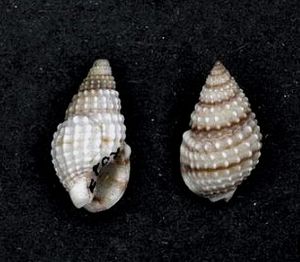Nassarius pyrrhus facts for kids
Quick facts for kids Nassarius pyrrhus |
|
|---|---|
 |
|
| Two views of a shell of Nassarius pyrrhus | |
| Scientific classification | |
| Kingdom: | |
| Phylum: | |
| Class: | |
| (unranked): |
clade Caenogastropoda
clade Hypsogastropoda clade Neogastropoda |
| Superfamily: |
Buccinoidea
|
| Family: |
Nassariidae
|
| Subfamily: |
Nassariinae
|
| Genus: |
Nassarius
|
| Species: |
N. pyrrhus
|
| Binomial name | |
| Nassarius pyrrhus (Menke, 1843)
|
|
| Synonyms | |
|
|
Nassarius pyrrhus, also known as the red-banded nassa, is a type of sea snail. It's a marine gastropod mollusk that belongs to the Nassariidae family. This family includes many "nassa mud snails" or "dog whelks." These snails are found in the ocean and are known for their unique shells.
What Does It Look Like?
The shell of the red-banded nassa is usually between 14 mm and 22 mm long. That's about the size of a small button or a large pea!
The shell has a shape that's a bit like an egg and a cone. It has a short, pointed top part called the spire. This spire is made up of seven or eight rounded sections called whorls. These whorls have small bumps, or "nodules," near the top. The whole outside of the shell has wavy lines, called longitudinal folds.
On the main, largest part of the shell (the body whorl), these folds sometimes fade away near the edge of the opening. At the bottom of this main whorl, you might see a few thin lines that cross over the folds, making tiny bumps. The opening of the shell, called the aperture, is whitish and somewhat round, but a little narrower at the top. The thick outer edge of the opening, called the lip, has a slight ridge on the outside. The inside of this lip has many fine lines.
Where Does It Live?
This snail species is endemic to Australia. This means it is found only in Australia and nowhere else in the world! You can find Nassarius pyrrhus living off the coasts of several Australian states, including:

